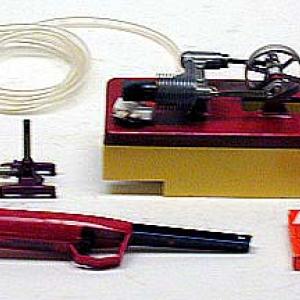College of Liberal Arts & Sciences
4F30.10 - Stirling Engine
Video Credit: Jonathan M. Sullivan-Wood.
The fuel pellets seem to run this the best although the Bunsen burner will work. Lubrication is critical as any friction will keep the engine from starting or running. A drop of oil on the two flywheel bearings and the main piston shaft will usually be required. DO NOT OVER LUBRICATE THE PISTON SHAFT!! DO NOT USE OIL ON THE EXTERNAL SILVER PISTON - A very small amount of graphite is to be used ONLY WHEN NEEDED!! When the heated chamber reaches a sufficient temperature a small turn of the flywheel in the counterclockwise direction will start the engine.
The multi-gang Stirling engine is very cool. Fill all 4 burner reservoirs with alcohol to the marked level. Allow a few seconds for the alcohol to wet the wicks. Light all 4 reservoirs, and in about 20 seconds you will be able to start the unit by turning the flywheel in the marked direction. This is a very smooth running unit.
- Richard E. Stevens, Karen E. Stevens, Ryan L. Grady, Laura A. Stricker, "Measurement of Work and Power in a Coffee-Mug Stirling Engine as a First-Year Physics Laboratory", TPT, Vol 61, #5, May 2023, p. 396.
- Y. J. Lu, Hiroko Nakahara, and J. S. Bobowski, "Quantitative Stirling Cycle Measurements: P-V Diagram and Refrigeration", TPT, Vol. 58, #1, Jan. 2020, p. 18.
- H. Richard Crane, "The Stirling Engine—173 Years Old and Running", TPT, Vol. 28, #4, Apr. 1990, p. 252.
- R. D. Spence and C. L. Foiles, "Stirling Engines for Demonstration", TPT, Vol. 20, #1, Jan. 1982, p. 38.
- Alejandro Romanelli, "The "Spring" Stirling Engine", AJP, Vol. 90, #3, March 2022, p. 218.
- Raul A. Simon, "Stirling's Cycle and the Second Law of Thermodynamics", AJP, Vol. 52, #6, June 1984, p. 496.
- Harvey S. Leff, "Heat Engines and the Performance of External Work", AJP, Vol. 46, #3, Mar. 1978, p. 218.
- Richard Fitzgerald, "Traveling-Wave Thermoacoustic Heat Engines Attain High Efficiency", Physics Today, Vol. 52, #6, June 1999, p. 18.
- Jearl Walker, "The Amateur Scientist: A Backyard Version of the Stirling Engine Can Be Built with Common Materials", Scientific American, Vol. 262, #1, Jan. 1990, p. 140.
- Jearl Walker, "The Amateur Scientist: Experiments with the External-Combustion Fluidyne Engine, Which Has Liquid Pistons", Scientific American, Vol. 252, #4, Apr. 1985, p. 140.
- Graham Walker, "The Stirling Engine", Scientific American, Vol. 229, #2, Aug. 1973, p. 80.
- G. D. Freier and F. J. Anderson, "Hn-4", A Demonstration Handbook for Physics.
- A. D. Bulman, "A Simple Heat Engine", Model-Making for Physics, p. 21.
- James R. Senft, "An Introduction to Stirling Engines", Moriya Press, 1993.
- Ron Hipschman, "Heat Pump", Exploratorium Cookbook II, p. 129.1 - 129.4.
- "Stirling Engine" & "Stirling - the Forgotten Engine", The New Illustrated - Science and Invention Encyclopedia.
- "A Brief History of Stirling Cycle Engines".
Disclaimer: These demonstrations are provided only for illustrative use by persons affiliated with The University of Iowa and only under the direction of a trained instructor or physicist. The University of Iowa is not responsible for demonstrations performed by those using their own equipment or who choose to use this reference material for their own purpose. The demonstrations included here are within the public domain and can be found in materials contained in libraries, bookstores, and through electronic sources. Performing all or any portion of any of these demonstrations, with or without revisions not depicted here entails inherent risks. These risks include, without limitation, bodily injury (and possibly death), including risks to health that may be temporary or permanent and that may exacerbate a pre-existing medical condition; and property loss or damage. Anyone performing any part of these demonstrations, even with revisions, knowingly and voluntarily assumes all risks associated with them.
